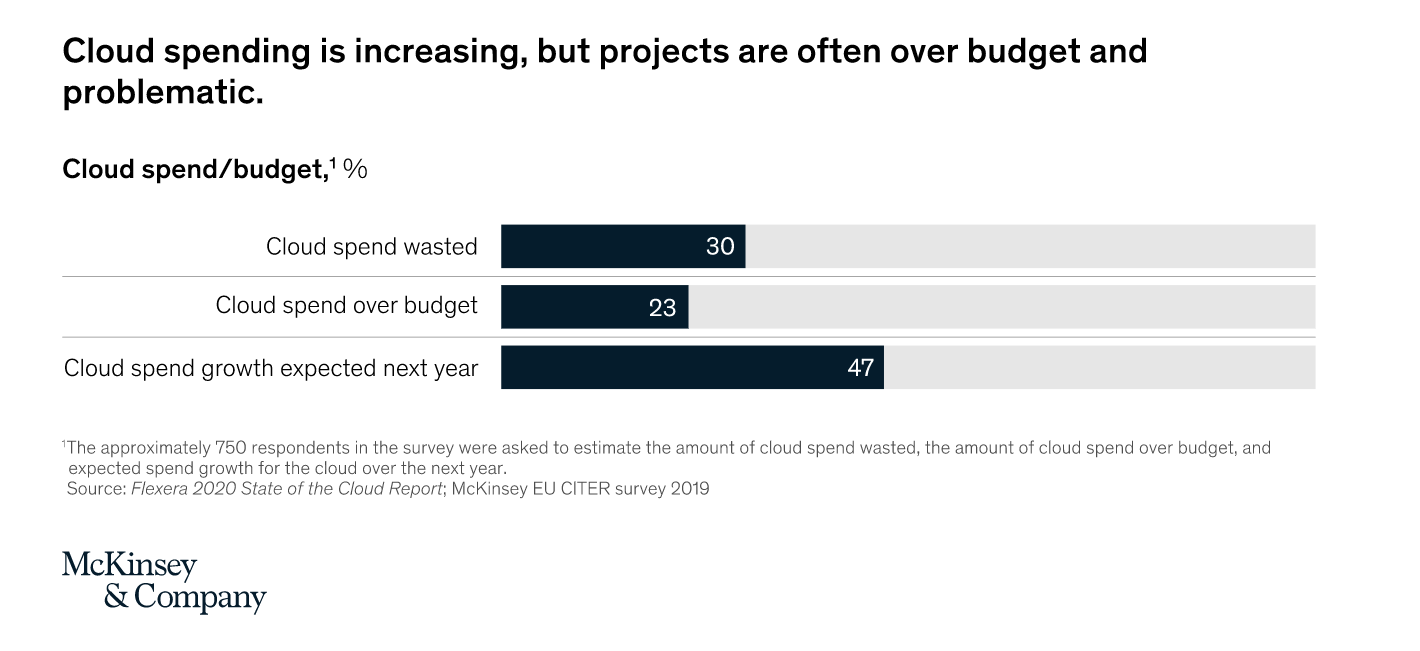- Advertising
- Bare Metal
- Bare Metal Cloud
- Benchmarks
- Big Data Benchmarks
- Big Data Experts Interviews
- Big Data Technologies
- Big Data Use Cases
- Big Data Week
- Cloud
- Data Lake as a Service
- Databases
- Dedicated Servers
- Disaster Recovery
- Features
- Fun
- GoTech World
- Hadoop
- Healthcare
- Industry Standards
- Insurance
- Linux
- News
- NoSQL
- Online Retail
- People of Bigstep
- Performance for Big Data Apps
- Press
- Press Corner
- Security
- Tech Trends
- Tutorial
- What is Big Data
Bare Metal vs Public Cloud: Where to Migrate in 2021?
Many businesses and enterprises still keep their infrastructure on-premises due to security issues, migration struggles, or vendor lock-in fears. The COVID-19 pandemic, however, has led to a growth in cloud services: many have migrated their businesses quickly, without a proper plan in place, looking only for the hearsay benefits. This has backfired due to higher costs, poor implementation, no governance, and even cybersecurity threats.
However, there are better alternatives. Opting for a bare metal provider and a hybrid cloud strategy can save your business costs and allows you to benefit from greater security and flexibility, as compared to moving to the public cloud or adopting a multi-cloud strategy. Why? Find out below.

Cloud Trends During and After the Pandemic
Gartner analyst, David Cappucio predicted that by 2025, 80% of enterprises will give up their traditional on-premise data centers and look to the cloud. A survey from April 2020 with 50 CIOs found that respondents expected to see the proportion of total workload done on-premises drop from 59% in 2019 to 38% in 2021, a reduction of 41%. These CIOs also expect the public cloud’s proportion of total workload to grow from 23% to 35% in the same period.
With the onset of the COVID-19 pandemic, this move to the cloud has accelerated even more. In a survey by MariaDB, 31.8% of the respondents said they will start migrating to the cloud, 51% mentioned they will move more applications to the cloud, and 38.6% responded they will be 100% on the cloud. But many of the businesses that have migrated quickly to the cloud since the pandemic started encountered business and technical problems. Why?
Firstly, they found out the public cloud comes with hidden costs. Besides the doubled cost during the migration process - since they needed to run both their data center and the cloud during transition, there also met additional costs for add-on services that can be 3 to 4 times more expensive if not configured properly, there was poor data governance throughout the company before and during the switch. Additionally, the high system integrator will continue to generate costs money even years after moving to the cloud.
Secondly, most companies that migrated to the cloud during the pandemic did so quickly with no well-defined roadmaps or skilled teams to cover and oversee the process in detail, as normally necessary. Moving to the cloud is a complex operation and in order to reduce costs and to fully reap the business value of the cloud in the future, it needs to follow some definitive guidelines, governance at company level, a skilled team, and a proper configuration from the beginning.
Thirdly, companies that opted for multi-cloud deployments for high availability and disaster recovery reasons encountered security, connectivity, and operational challenges. Besides the advantages that multi-cloud brings, it can also add an entirely new set of problems that we will discuss later.

Differences between Public Cloud, Private Cloud, Multi-Cloud, Hybrid Cloud, and Bare Metal Servers
In the past, public clouds, private clouds, multi-clouds, and hybrid clouds were defined by ownership and location. Now this distinction is pretty much obsolete, since the offerings have changed throughout the years, so that it is now possible for the public cloud to also offer private cloud features, while IaaS allows for both public cloud and private cloud configurations on rented, vendor-owned data centers located off-premises.
We will briefly describe these terms, but keep in mind that no two clouds are the same; they differ from a configuration point of view, and each uses a unique mix of technologies (OS, management platform, application programming, interfaces, APIs, virtualization or no-virtualization, automation software, etc.).
In a nutshell:
Public clouds are cloud environments created from IT infrastructure not owned by the end user, and are operated off-premises by definition.
Private clouds are cloud environments dedicated to a single end user, usually in an environment that runs behind their firewall. Any cloud becomes a private one if it is used and can only be accessed by a single customer. Private clouds can be managed or dedicated.
Multi-clouds are cloud environments made up of two or more public clouds, from different providers. Multi-cloud refers to having your data in multiple public clouds for redundancy, high availability, and disaster recovery reasons.
The hybrid cloud is a cloud-computing environment where you can connect the public cloud, the private cloud, and your on-premises infrastructure; this offers greater security for data that is essential to you, but also the flexibility to use the apps on the best corresponding infrastructure and structure. An additional benefit is the option of using diverse cloud functionalities for specific workloads.
Essentially, all hybrid clouds are multi-clouds, but not all multi-clouds are hybrid clouds, and they are not mutually exclusive. A business that orchestrates workloads between on-prem, a private cloud, and multiple public clouds can be defined as having both a hybrid cloud and a multi-cloud strategy.
The bare metal servers close the gap between the traditional server types – dedicated servers – and the cloud, as they provide both the power and security of dedicated servers and some of the versatility and flexibility of cloud machines. Unlike cloud solutions, bare metal servers don’t use a hypervisor and have direct access to all hardware resources.
Thinking of Migrating from On-Premises to the Cloud?
The public cloud offers many advantages. Since cloud providers use world-class facility designs, cooling systems, energy-efficient solid-state drives, and workload optimized equipment, opting to migrate to the cloud would reduce your costs compared to keeping everything on-prem and buying the hardware yourself.
However, while cloud providers take advantage of multi-tenancy to get more efficiency out of their resources, it can bring about additional costs, security concerns, and vendor lock-in issues for your business.
Going for a multi-cloud solution involves an even higher complexity, and can lead to poor configuration of the public clouds (you need different skills sets to handle each of them), vendor lock-in issues and security challenges.
Challenges in Running a Multi-Cloud Strategy
What challenges can you encounter if you opt for a multi-cloud strategy?
- Hidden egress charges
- Storage cost
- Additional cost for re-platforming apps before moving to the cloud
- Difficulties in integrating existing data
- No expertise in the complexity of each public cloud platform
- Lack of experience for integrating multiple public clouds
- Utilizing diverse functionalities from multiple clouds
- Big data workloads can be tricky to handle
There’s a whole list of advantages and disadvantages for keeping everything on-prem vs migrating to cloud. So, what do we recommend?
Advantages of a Bare Metal Server Infrastructure
Bare metal IaaS represents a midway solution that can help you reduce business costs, be certain of security due to single-tenant servers, and make use of rapid deployment.
Generally speaking, dedicated servers are known for their power but also the slow deployment and a difficult migration process. Bare metal servers have addressed these issues and have revolutionized the industry by offering both the security of physical machines, and the flexibility normally found in public cloud, including rapid provisioning and deployment. Unlike normal dedicated servers, bare metal servers can be deployed in minutes.
Bare metal servers generally use top-of-the-line hardware products: latest generation processors, NVMe solid state drive with fast load times, and the best available RAM.
In terms of performance, the bare metal server - at its core a dedicated server - will almost always outperform a cloud machine, since it has direct access to the processing resources. The hypervisor layer makes virtualized solutions (cloud) less performant than single-tenant, non-virtualized servers.
What’s the Best Alternative for the Public Cloud?
The best option is a cloud service provider that manages the infrastructure for you and offers both the security and power of dedicated servers and the flexibility of the cloud, in a cost-efficient offering. Here are a few things to consider when choosing your provider:
- Offers scalability on request through the use of a simple UI – no need to go to the data center to change the servers, it can be done in a few clicks from the interface.
- Uses techniques for reducing data storage requirements such as deduplication, data compression, snapshots, and automated provisioning.
- Uses automation.
- Uses remote monitoring systems.
- Upgrades to new IT equipment regularly - new IT equipment is generally more efficient and more performant than old technology.
- Does not lead to vendor lock-in as most public clouds.
The Trend in 2021? Best Go Hybrid.
Going hybrid can offer the security and privacy you need, while also allowing you to scale quickly and reduce costs, since the whole infrastructure can be customized specifically for your business. A hybrid cloud setup enables companies to move workloads freely between environments, and to automate and orchestrate processes in a single management platform.
Why adopt a hybrid cloud strategy?
- Scalability & resilience
- Security & compliance
- Resource optimization
- Cost saving
- Risk management
Before deciding on a migration process, however, you should do a full technical check-up of your business and understand the key steps towards a hybrid solution that can suit all of your business needs.
How to best achieve that?
First, asses your current applications and determine which to migrate and which to keep – there’s no need to move all of your data or apps at once, and you can adopt cloud operations in multiple environments, not just the public cloud. For instance, legacy apps continuously generate compute or high-performance storage charges. Any non-critical apps of this type should not be migrated to the cloud.
Second, check and adapt your IT operating model and restructure your teams, especially in DevOps, security, and infrastructure management.
Third, make a migration plan and think ahead of the technological necessities for any interconnected services such as the internet of things, SaaS offerings, and edge computing services.
The Metal Cloud platform developed by Bigstep includes many features that can help you migrate to a hybrid setup:
✓ Fast deployment: The entire process is automated, including server registration, switch and cable configuration.
✓ Low overhead: Unique, lightweight web socket microservices based control mechanism.
✓ Full data center automation: Automate servers, switches, storage and the bare metal servers.
According to a study published by IDC in March 2020, over 90% of enterprises worldwide will turn to a hybrid cloud strategy, by using a mix of on-premises and dedicated private clouds, multiple public clouds, and legacy systems to meet their infrastructure needs by 2022.
Are you ready to make the move and you’re considering bare metal servers? We’re here to talk. Want to learn more about servers? Download our free guide on servers.
Readers also enjoyed:

Combine the 3 Vs of Big Data with the 3 Ss of Bare Metal Servers


Leave a Reply
Your email address will not be published.